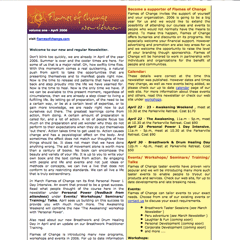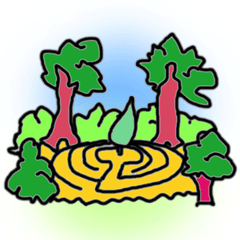
What is a labyrinth?
Labyrinths are old friends. They are playgrounds of both complexity and simplicity, which can be used for prayer, meditation, healing, divination, and - most importantly - fun. You can use them to look holistically at any issue. And they can be used by anybody, anywhere, at any time. You can walk them physically, or in the mind; you can draw one on paper to walk and keep it in a pocket or desk drawer. As can be seen, they are incredibly flexible tools.
You can be up and running in minutes, too. Their method of construction, learned in five minutes, is never forgotten. The infinite ways of working with them, so effortlessly brought into your waking life, is breathtaking; and you will be surprised by the charm labyrinths hold for your subconscious, for if you are drawn to these tools, you will find yourself working with them in dreams.
In my workshops I share methods of using labyrinths to discover and energise goals, particularly the promises made long ago to yourself that have been ‘buried’ by the avalanche of adult daily life. Or, ways to establish a deeper connection with Spirit, using the divine creative power each of us is imbued with. I share how to use these tools for healing, of yourself and others; how to empower ourselves as artists with these tools, for I believe the creative spark is divine. Whether used for a deeper connection or as a dance floor for the best parties in town, labyrinths have many uses and provide extraordinary results.
Why do they work? They have been around for 4,000 years, and while recorded history of their use (until the last eight centuries) is scant or nonexistent, what little clues remain - in myth and folklore - make clear that the key ingredient for their charm and usefulness is imagination. Scandinavian fishermen built them in coastal areas, and before setting out to sea would walk the pattern to leave evil spirits trapped inside the labyrinth. In Britain, young men ran a labyrinth to ‘win’ the woman at the centre. In Gothic cathedrals in France, the labyrinth was a ‘mini pilgrimage’, made in the nave before advancing to the altar and connection to God. In all these examples, a specific intent was made by the walker (to overcome negative energy, to see oneself achieving a goal) and acted out within the labyrinth’s pattern. The labyrinth was used to ‘act out’ and to practically manifest a desired outcome.
In working with labyrinths over the last two decades, I’ve found that just one ‘rule’ needs to be applied when exploring the self with these tools - that whatever happens inside the labyrinth is part of the answer to the question you have asked; is guidance on the issue you are next to work upon. Once you open to this discipline, the results are far-reaching.

Each labyrinth is a sacred space, because it is created by our intention. Sacred space is any place you come to with a prayer in your heart - whether in the bush, the concrete street you are walking along, or the landscape you have created in meditation (or in a dream). The labyrinth we work with in this workshop, the Classic labyrinth, was the first labyrinth pattern that evolved - from which all other forms, including the maze, developed. I think its power lies in the fact it combines two ancient symbols: the spiral, symbol for growth and the infinite, an unending expansion; and the circle, symbol for wholeness and the absolute, completion and Spirit. The labyrinth marries our yearning to grow, to fulfil our potential, to advance ourselves and those around us, with the many resources we have been given to do this. We already have the tools - the answers - inside us; the labyrinth’s playground acts as a microcosm of each person’s universe, gently leading us to these answers through insight and rediscovery.
The labyrinth therefore is powerful from the symbolism it contains, and also from the fact that is an energetic symbol - created when we walk it. The labyrinth works because it is a tool that requires our participation; in this context of using labyrinths - for working on ourselves, and connecting with our higher selves - the labyrinth only comes into being when we create it. It demands our interaction, and by being our own unique creation, every time, this spiritual tool allows us to create our own individual path, our own unique adventure - our own personal playground containing just ourselves, and Spirit. The ways of creating your labyrinths are many; the ways of working with your labyrinths are infinite. The child inside you, and the adult navigating life at this second, can both commune and play in its safe circuits.
For this reason, in the warmest sense of the word, labyrinths are old friends.

